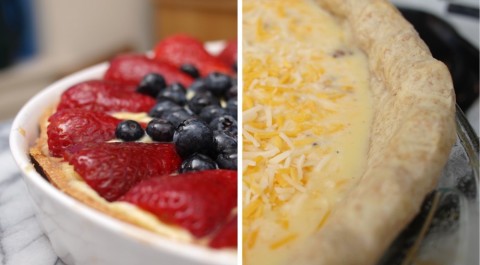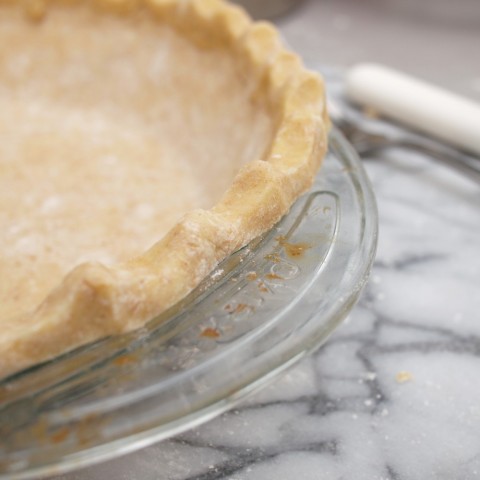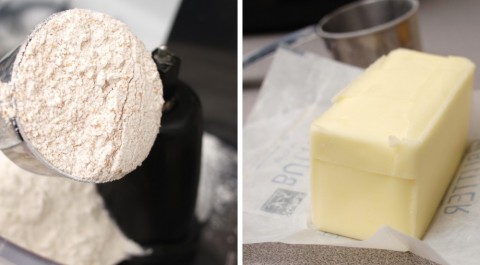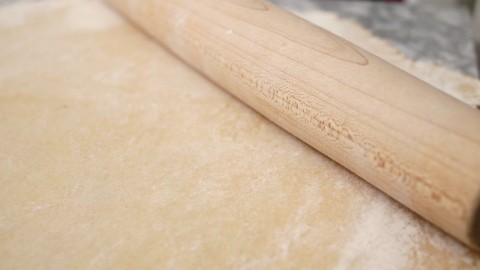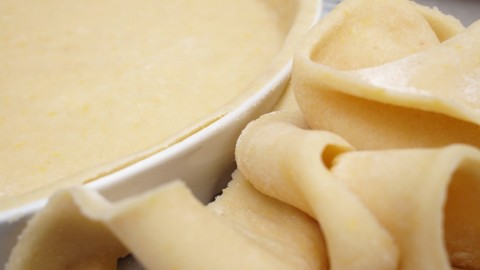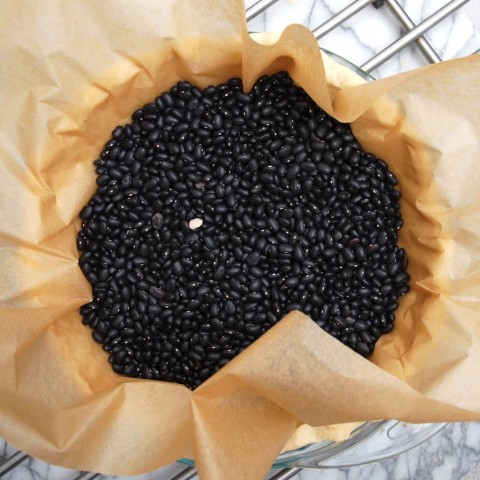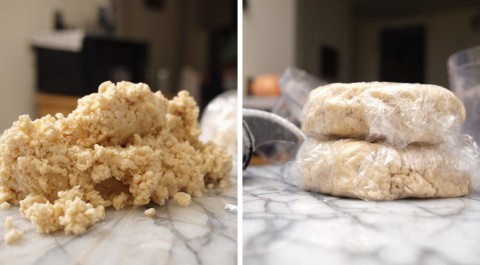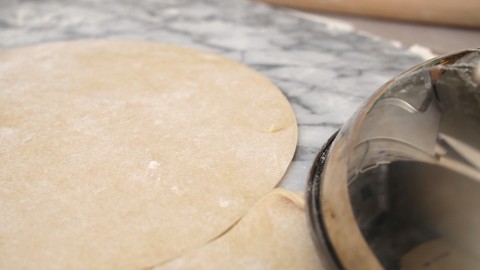It has begun, dear friends, to seem a bit absurd to me that every time I make a pie, tart, or pasty for the blog, I provide instructions for making shortcrust pastry all anew. As I browse back through the last few months’ entries, this habit, it seems to me, is responsible for taking up quite a lot of space.
And so I thought to myself this morning — I thought: why not write a shortcrust primer, instead? Why not work up a master recipe that will recount my shortcrust technique, its major variations, and maybe offer just a couple of tips for making it work?
I started writing. And before I knew it, I had not a recipe on my hands, but a FAQ. I had eleven common shortcrust questions, complete with detailed answers, to go with what amounts to a short, simple recipe.
The recipe itself, which is way down at the bottom, will show you how to make a crust that’s appropriate for sweet or savory applications, and that can be made crisp and flaky by using chilled water, or tender and crumbly by using an egg yolk and some cream.
But the more valuable part of this post, I think, is the question and answer section. The fact that I got so carried away with that part means that it’s chock full of good advice for blind baking, and dealing with soggy crusts, and whatever else you’ve ever wanted to know about shortcrust (but were afraid to ask). The fact that I got so carried away means that you can very reasonably forget about any specific pie I’ve ever made here at Twice Cooked. Invent your own filling, follow the advice here, and in the words of the immortal Terry Pratchett: the world will be your mollusk.
Enjoy!
What is shortcrust pastry?
According to the trusty Wikipedia: shortcrust pastry is a type of pastry often used for the base of a tart, quiche or pie. … [It] can be used to make both sweet and savory pies such as apple pie, quiche, lemon meringue or chicken pie. Many shortcrust pastries are prepared using vegetable shortening, a fat food product that is solid at room temperature, the composition of which lends to creating crumbly … pastries and pastry crusts.
But that’s not what you really want to ask me. What you really want to know is why I call it “shortcrust,” and not “pie crust,” or something fancy and French like “pate brisée.”
The reason for this is that I find shortcrust to be the most descriptive word for it. It is a pastry crust, after all, that is made with fat — shortening. Shortcrust doesn’t always turn out to be a pie crust, or a tart crust. It can be other things, too. And I don’t particularly care for borrowing terms from other languages when we have perfectly good ones in English. Brisée, in French, means “broken.” What’s up with that? It only refers to one common type of shortcrust. And besides, my pronunciation of French is so bad that uttering even something as simple as pate brisée out loud always makes me feel like a bit of a fool.
So — shortcrust it is.
So … Wikipedia mentioned that I might want to use lard or vegetable shortening to make my shortcrust crumblier. Should I?
No. Or, at least, I’ve never found it necessary. All of the shortcrust here at Twice Cooked is made with unsalted butter. And my crusts tend to garner comments like: Wow, this is really tender and flaky! What have you done? Or: I’ve never especially cared for pie crust before, but you make me want to learn to make it at home!
I tend to rely on the composition of the binding liquid in the crust to control its texture. If I’m looking for a really tender, crumbly crust — like for a delicate tart — I’ll make it with an egg yolk and cream. If I’m looking for a flaky, slightly crispy crust, I’ll make it with ice water.
I also modify my technique for rolling out the crust, depending on the texture I’m looking for. For a flaky, crispy crust, I’ll roll it out, then fold the crust in four, and roll it out again. This, I find, creates a delicious layered effect — almost like puff pastry, but without the puffiness.
How do I roll my shortcrust out to an even thickness?
You can buy rings for your rolling pin, to ensure that your crust gets to the thickness you desire, and no thinner. But really, it’s not necessary. Experience, and the spread of your crusts (which should be about an inch wider, all around, than your pie pan) will guide your hand.
As to rolling evenly, I would suggest the following: on a floured pastry board, roll your initial lump of dough five or six times, spreading it as best you can in every direction. Flip the dough over, and roll it away from you, then toward you. Flip again, turn about forty-five degrees, roll away, then toward, and repeat, over and over again until your crust is the right size.
It will take some practice, but if you apply even pressure with every roll, and if you are fastidious about rotating the dough as you roll it, your crust will come out even — or at least even enough.
How large should I roll it?
As I said in the last answer, if your intent is to make a pie, the finished crust should be about an inch wider than the dish you intend to put it into.
How do I keep the dough from sticking to my rolling pin?
Flour. And it’s just as good for keeping the dough from sticking to your counter or pastry board. Some folks have concerns, I know, about adding too much flour to shortcrust dough, on the theory that it will make it too dense, or too dry, or ruin the texture. But consider: when you’re putting your dough together initially, you want to use the minimum quantity of liquid possible to allow the dough to just barely come together. The idea is to preserve its crumbly texture. Why, then, would adding flour later destroy the texture?
Used in moderation — and I emphasize the moderation point — it won’t do your dough any harm. And certainly, it will do less harm to your dough than turning it into a sticky mess.
Once it’s in the dish, how do I make my pie crust pretty?
This — this is a matter of taste and practice. If you’re planning to do a bottom-only pie, here is what I would recommend. Press your rolled pie crust into its dish, allowing any excess dough to hang over the side. With a paring knife, trim the dough so that you have an even quarter to half an inch all around, and then roll the overhang up so that it forms a lip, just above the lip of the dish. Finally, with two fingers and a thumb, pinch the lip of the pie at even intervals all the way around, forming a series of depressions. They don’t need to be exactly even. If some are a little closer together than others, the final crust will still come out more than tolerably pretty.
If you’re doing a top and a bottom, there are two possibilities that I would recommend. For both, press your bottom crust into the dish, trim the overhang to half an inch with a paring knife, and fill the pie. To make a solid top, place the second crust gently over the filling. Trim it so that its overhang is about even with the bottom. And then, as before, roll the crusts up so that they form a lip, and crimp with your three fingers. Remember to pierce the top crust (in any pattern that’s pleasant to you) before you bake.
Or alternately, if you plan to do a lattice pie, weave the lattice over the filled bottom crust one strip at a time, at a ninety degree offset. Remember that you need to make sure that your lattice goes in an over-under pattern, across the surface of the pie. When the weaving is done, trim each of the lattice strips to half an inch, roll the lip up as before, and crimp. Simply Recipes has directions for doing this that are much clearer than I think I could be.
In either case, if you’re making a pie that has a top crust, I would recommend an egg wash before you bake, to give the crust a pleasant sheen. To do this, beat an egg with a little bit of water. And then, with a pastry brush, lightly brush the egg over the crust right before it goes in the oven.
Finally, if you’re making a tart, it’s a little bit of a different matter, as you want the crust of the tart to come up just to the top of the pan, and no more. In this case, I would recommend pressing your crust into the tart pan, and pressing around the walls to make sure that it holds fast. Then, I would recommend running your rolling pin over the top of the pan, across the overhanging dough. This will sever the dough precisely at the top of the pan, and give you a perfect crust every time.
How do I keep my shortcrust from shrinking in the oven?
Easily! That’s how. Once you’ve rolled out your crust, placed it in the pie pan, and crimped the edges, stick that crust back in the refrigerator. An hour, or even a half hour, in the cold will give it time for any gluten formed during the rolling process to relax. And it’s gluten that makes your crust pull away from the pan.
If you have a top crust, I’d recommend rolling it out, and then rolling it up in a piece of parchment and refrigerating it, too. The minimal amount that you’ll end up working it as you lay it over the top of your filled pie won’t do anything at all to undo the felicitous effects of refrigeration.
How do I keep my crust from forming bubbles as it bakes?
Again: easily! I’m given to understand that one common problem for folks who make pies is that during baking, air gets trapped under the bottom crust, bubbles up, and displaces the filling. I’ve never had this happen, personally. And the reason is that I am fastidious about puncturing the bottom crust all over with a fork before I add any filling.
But doesn’t that lead to soggy crusts, you ask? No! The fork pricks are big enough to let air escape, but small enough that goopy pie fillings can’t seep down under the crust and gum it up.
And yet: goop from my pie’s filling keeps making the crust soggy. What do I do?
The best answer to this is blind baking. Prepare your pie crust in its plate, refrigerate it, and then rather than filling it right away, line it with parchment, weight it down with uncooked beans or rice, and bake it at 400F for 20-25 minutes, until the edges of the crust just barely start to turn golden. Then take it out of the oven, remove the parchment (being sure not to spill any of the weights), and fill your crust like normal. It’ll have to be one soupy goopy filling to sog your crust after that!
Of course — blind baking assumes that you don’t plan to have a top crust on your pie. If you do plan to have a top crust, you’ll need to take slightly different steps. I would recommend: 1) rolling out your bottom crust a little bit on the thick side; 2) painting the bottom crust with melted jam (if you’re making a sweet pie) or egg white (if your pie is savory); and 3) refrigerating (or freezing) your pie crust for an additional half hour before filling and baking. None of these steps are as sure as blind baking, but together, I’ve found that they do a good job of keeping crusts intact.
Should I invest in pie weights?
No. Not unless you want to. I’ve found that uncooked beans — or even better, rice — work just fine for blind baking crusts. And if you store them in an airtight container in the freezer, they can be used over and over again without going rancid.
What about freezing shortcrust pastry?
Because I have terrible difficulty planning ahead, I don’t usually make shortcrust pastry to freeze. But you can! And it comes out very well!
In order to do it, roll your crust out, just like you would when making a pie. Then gently, carefully, move your crust onto a sheet of parchment, and roll it up, making sure that there’s no crust-to-crust contact. When you have your rolled crust, wrap it in a layer of plastic wrap, and a layer of tin foil, and freeze.
When you’re ready to use it, remove the bundle from the freezer, take off the tin foil, and allow it to soften slowly, probably over about forty-eight hours, in the refrigerator.
(I haven’t done a scientific test, but I imagine that a crust that uses water as the binding liquid would freeze and defrost better than a crust that uses egg yolk and cream.)
Alright — now you’ve blathered quite a bit. How about a recipe?
1 1/4 cups Unbleached AP White Flour (or one cup of white, and a quarter of a cup of wheat, for a rustic crust)
1/2 cup Unsalted Butter, cubed and chilled
3 tbsp Cold Liquid (water if you want a crispier crust, or egg yolk and cream if you want a tenderer one)*
2 tbsp Granulated Sugar (if you’re using the crust for something sweet)
1/2-1 tsp Salt
To the workbowl of a food processor, add the flour, salt, and sugar (if you’re using it), and pulse once to mix. Add the cubed butter, and pulse a couple of times, in five second intervals, until it is incorporated and the mixture is the texture of sand. Then add the liquid, and keep pulsing until it all just barely comes together into a dough.
Remove the contents of the workbowl onto a piece of plastic wrap. Use the plastic wrap to shape the dough into a puck, making sure not to work it too much, to prevent gluten from developing. Wrap the puck, and chill it in the refrigerator for at least half an hour.
At the end of that time, remove the puck of dough from the refrigerator, and on a lightly floured board, roll it into a circle about an inch wider than your pie pan. Lay it into the pan, pressing it into the corners so that it fits snugly. Use a fork to perforate the bottom, trim the overhanging dough to half an inch, and then refrigerate for at least half an hour before filling.
This recipe can be easily doubled if you need to make a top and bottom crust for your pie. In that case, I would recommend splitting the dough, as it comes out of the food processor, into two pucks. That should make it easier to handle later.
For sweet tarts, especially, you might consider adding some flavor to the dough. I often find that adding the zest of a lemon to a fruit tart does a nice job of making the crust compliment the filling.
And this recipe can, of course, also be used for purposes other than a pie crust. You can see, here, some slightly different instructions for making hand pies. But it would be just as easy to use this recipe to make, say, edible ice cream dishes by laying rounds of crust inside oven-proof bowls.
* The yolk of a large egg is equal to about one tablespoon. I would recommend using one yolk plus two tablespoons of cream per crust.
